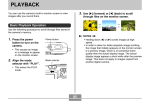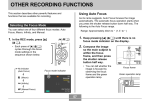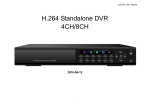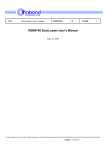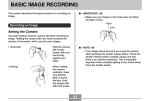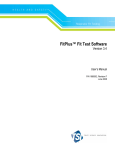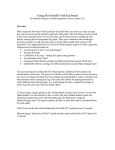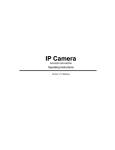Download File 2 - Support
Transcript
OTHER RECORDING FUNCTIONS OTHER RECORDING FUNCTIONS This section describes other powerful features and functions that are available for recording. Using Auto Focus As its name suggests, Auto Focus focuses the image automatically. The automatic focus operation starts when you press the shutter release button down half way. The following is the Auto Focus range. Selecting the Focus Mode You can select one of five different focus modes: Auto Focus, Macro, Pan Focus, Infinity, and Manual. 1. In the REC mode, press [왖] ( ). [왖 ] ( Range: Approximately 40cm to ∞ (1.3´ to ∞) 1. Keep pressing [왖] ( ) until there is no focus mode indicator on the display. ) MENU 2. Compose the image • Each press of [왖] ( ) cycles thorough the focus mode settings in the sequence shown below. No indicator (Auto Focus) (Macro) so the main subject is within the focus frame, and then press the shutter release button half way. SET DISP • You can tell whether the image is focused by observing the focus frame and the green operation lamp. Focus mode indicator PF (Pan Focus) (Infinity) MF (Manual Focus) 59 99 1600 1200 NORMAL IN 1 / 1000 F2.6 03/12 03 12/24 24 12:58 12 58 Focus frame Green operation lamp OTHER RECORDING FUNCTIONS When you see this: It means this: Green focus frame Green operation lamp The image is focused. Red focus frame Flashing green operation lamp The image is not in focus. 3. Select the Auto Focus area you want, and then press [SET]. 3. Press the shutter release button the rest of the way to record the image. ■ Specifying the Auto Focus Area You can use the following procedure to change the Auto Focus area used in the Auto Focus Mode and the Macro Mode. Note that the configuration of the focus frame changes in accordance with the Auto Focus area you select. 1. In the REC mode, press [MENU]. For this type of Auto Focus area: Select this: Very limited range in the center of the screen • This setting works well with focus lock (page 64). Spot Automatic selection of the focus area where the subject closest to the camera is located • With this setting, a wide focus frame, which contains seven focus points, appears on the monitor screen first. When you press the shutter release button half way, the camera automatically selects the focus point where the subject closest to the camera is located, and a focus frame appears at that point. • This setting works well for group photos. Multi • Spot • Multi 2. On the “REC” tab, select “AF Area”, and then press [왘]. Focus frame 60 Focus frame OTHER RECORDING FUNCTIONS Using the Macro Mode Using the Pan Focus Mode The Macro mode lets you focus automatically on close up subjects. The automatic focus operation starts when you press the shutter release button down half way. The following is the focus range in the Macro mode. Normally, your camera performs Auto Focus to ensure that your images are always in focus. With Pan Focus, focus is fixed for a specific focal distance, and images are recorded without Auto Focus. The focus range depends on the zoom setting, the amount of light available when recording, and other recording conditions. Approximately 6cm to 50cm (2.4˝ to 19.7˝) 1. Keep pressing [왖] ( ) until the focus mode indicator shows “ ”. 2. Record the image. • The focus and image recording operations are identical to those in the Auto Focus mode. • You can tell whether the image is focused by observing the focus frame and the green operation lamp. The indications of the focus frame and green operation lamp are the same as those in the Auto Focus mode. IMPORTANT! • In the Macro mode, the optical zoom range is 1x to 1.8x. 61 OTHER RECORDING FUNCTIONS 1. Keep pressing [왖] ( Using the Infinity Mode ) until the focus mode indicator shows “PF”. The Infinity mode fixes focus at infinity (∞). Use this mode when recording scenery and other faraway images. 2. Press the shutter release button all the way down. 1. Keep pressing [왖] ( indicator shows “ NOTE • If you press the shutter release button half way, the focus distance will appear on the monitor screen. 2. Record the image. IMPORTANT! • When using the flash, it is recommended that you have the zoom set to wide angle. 62 ) until the focus mode ”. OTHER RECORDING FUNCTIONS 2. While watching the Using Manual Focus image on the monitor screen, use [왗] and [왘] to focus. With the Manual Focus mode, you can adjust the focus of an image manually. The following shows focus ranges in the Macro mode for two optical zoom factors. Optical Zoom Factor Approximate Focus Range 1X 6cm (2.4˝) to infinity (∞) 3X 18cm (7.1˝) to infinity (∞) Manual focus position 1. Keep pressing [왖] ( ) until the focus mode indicator shows “MF”. • At this point, a boundary also appears on the display, indicating the part of the image that will be used for manual focus. To do this: Do this: Focus out on the subject Press [왗]. Focus in on the subject Press [왘]. • Pressing [왗] or [왘] causes the area inside of the boundary displayed in step 1 to fill the monitor screen momentarily to aid in focus. The normal image reappears a short while later. 3. Press the shutter release button to record the Boundary image. IMPORTANT! • In the Manual Focus mode, the [왗] and [왘] keys adjust focus, even if you used key customization to assign other functions to them (page 85). 63 OTHER RECORDING FUNCTIONS 2. Keeping the shutter Using Focus Lock Focus lock is a technique you can use to focus on a subject that is not located within the focus frame when you record an image. You can use focus lock in the Auto Focus mode and the Macro mode ( ). release button half way down, recompose the image as you like. 1. Using the monitor • This locks the focus on the subject that is currently within the focus frame. screen, compose the image so the main subject is within the focus frame, and then press the shutter release button half way. 99 1600 1200 NORMAL IN 1 / 1000 F2.6 99 1600 1200 NORMAL IN 1 / 1000 F2.6 03/12 03 12/24 24 12:58 12 58 3. When the image is composed the way you want, press the shutter release button the rest of the way to record it. 03/12 03 12/24 24 12:58 12 58 • The focus and image recording operations are identical to those in the Auto Focus mode. Focus frame • You can tell whether the image is focused by observing the focus frame and the green operation lamp. The indications of the focus frame and green operation lamp are the same as those in the Auto Focus mode. NOTE • Locking the focus also locks the exposure. 64 OTHER RECORDING FUNCTIONS 3. Use [왖] and [왔] to Exposure Compensation (EV Shift) change the exposure compensation value, and then press [SET]. Exposure compensation lets you change the exposure setting (EV value) manually to adjust for the lighting of your subject. This feature helps to achieve better results when recording a backlit subject, a strongly lit subject indoors, or a subject that is against a dark background. • Pressing [SET] registers the displayed value. EV value EV Shift Range: –2.0EV to +2.0EV Steps: 1/3EV Up : Increases the EV value. A higher EV value is best used for light-colored subjects and backlight subjects. 1. In the REC mode, press [MENU]. 2. Select the “REC” tab, select “EV Shift”, and then press [왘]. Down : Decreases the EV value. A lower EV value is best for dark-color subjects and for shooting outdoors on a clear day. Exposure compensation value 65 OTHER RECORDING FUNCTIONS • To cancel EV Shift, adjust the value until it becomes 0.0. Adjusting White Balance The wavelengths of the light produced by various light sources (sunlight, light bulb, etc.) can affect the color of a subject when it is recorded. White balance lets you make adjustments to compensate for different lighting types, so the colors of an image appear more natural. 4. Record the image. IMPORTANT! • When shooting under very dark or very bright conditions, you may not be able to obtain satisfactory results even after performing exposure compensation. 1. In the REC mode, press [MENU]. 2. Select the “REC” tab, select “White Balance”, and then press [왘]. NOTES • Performing an EV shift operation causes the metering mode to switch automatically to center weighted metering. Returning the EV shift value to 0.0 causes the metering mode to change back to multi-pattern metering. • You can use key customization (page 85) to configure the camera to perform exposure compensation whenever you press [왗] or [왘] while in the REC mode. 66 OTHER RECORDING FUNCTIONS 3. Use [왖] and [왔] to select the setting you Adjusting White Balance Manually want, and then press [SET]. When shooting under these conditions: Normal conditions Under some light sources, automatic white balance under the “Auto” setting can take a long time to complete. Also, the auto white balance range (color temperature range) is limited. Manual white balance helps to ensure that colors are recorded correctly for a particular light source. Note that you must perform manual white balance under the same conditions you will be shooting under. You must also have a white piece of paper or other similar object on hand in order to perform manual white balance. Select this setting: Auto Outdoor daylight Shade Incandescent light bulb (reddish tinge) Fluorescent light (greenish tinge) Difficult lighting that requires manual control (See “Adjusting White Balance Manually”.) 1. In the REC mode, press [MENU]. Manual 2. Select the “REC” tab, select “White Balance”, and then press [왘]. NOTES • Selecting “Manual” changes white balance to the settings achieved the last time a manual white balance operation was performed. • You can use the key customization feature (page 85) to configure the camera so the white balance setting changes whenever you press [왗] or [왘] while in the REC mode. 3. Use [왖] and [왔] to select “Manual”. • This causes the object you last used to adjust manual white balance to appear on the monitor screen. 67 OTHER RECORDING FUNCTIONS 4. Point the camera at a white piece of paper or Using the BESTSHOT Mode similar object under the lighting conditions for which you want to set the white balance, and then press the shutter release button. Selecting one of the 21 BESTSHOT scenes automatically sets up the camera for recording a similar type of image. ■ Example Sample Scene • Portrait • Scenery • Night Scene • Night Scene Portrait A white piece of paper • This starts the white balance adjustment procedure. The message “Complete” appears on the monitor screen after white balance adjustment is complete. • Dim lighting or pointing the camera at a dark colored object while performing manual white balance adjustment can cause the procedure to take a long time to complete. 5. Press [SET]. • This registers the white balance settings and returns to the REC mode. 68 OTHER RECORDING FUNCTIONS 1. In the REC mode, press [MENU]. IMPORTANT! • Sample scene number 4 is Coupling Shot scene (page 72). Sample scene number 5 is a Pre-shot scene (page 74). • BESTSHOT scenes were not recorded using this camera. They are provided as samples only. • Images recorded using a BESTSHOT scene may not produce the results you expected due to shooting conditions and other factors. • After selecting a BESTSHOT scene, you can change to a different one by using [왗] and [왘] to scroll through available scenes. When the one you want is displayed, press [SET]. 2. Select the “REC” tab, select “REC Mode”, and then press [왘]. 3. Use [왖] and [왔] to select “ BESTSHOT”, and then press [SET]. • This enters the BESTSHOT mode and displays a sample scene. NOTE 4. Use [왗] and [왘] to select the sample scene • You can use the key customization feature (page 85) to configure the camera to enter the BESTSHOT mode whenever you press [왗] or [왘] while in the REC mode. Operation guidance and the currently selected BESTSHOT scene appear on the display for about two seconds after you enter the BESTSHOT mode this way, or if the camera is in the BESTSHOT mode when you turn it on. you want, and then press [SET]. 5. Record the image. 69 OTHER RECORDING FUNCTIONS 6. Use [왗] and [왘] to Creating Your Own BESTSHOT Setup display the image whose setup you want to register as a BESTSHOT scene. You can use the procedure below to save the setup of an image you recorded for later recall when you need it again. Recalling a setup you save automatically sets up the camera accordingly. 1. In the REC mode, press [MENU]. 7. Use [왖] and [왔] to 2. Select the “REC” tab, select “REC Mode”, and select “Save”, and then press [SET]. then press [왘]. 3. Use [왖] and [왔] to select “ • This registers the setup. BESTSHOT”, • Now you can use the procedure on page 69 to select your user setup for recording. and then press [SET]. • This enters the BESTSHOT mode and displays a sample scene. 4. Use [왗] and [왘] to display “Register User Scene”. 5. Press [SET]. 70 OTHER RECORDING FUNCTIONS ■ To delete a BESTSHOT user setup IMPORTANT! • BESTSHOT user setups are located in the camera’s built-in memory after the built-in sample scenes. • When a BESTSHOT user setup is recalled, the monitor screen in step 4 of the procedure on page 69 displays the text “Recall User Scene”. • Note that formatting the built-in memory (page 132) deletes all BESTSHOT user setups. 1. In the REC mode, press [MENU]. 2. Select the “REC” tab, select “REC Mode”, and then press [왘]. 3. Use [왖] and [왔] to select “ BESTSHOT”, and then press [SET]. NOTES • This enters the BESTSHOT mode and displays a sample scene. • The following are the settings that are included in a BESTSHOT user setup: focus mode, EV shift value, white balance mode, flash mode, and ISO sensitivity. • Note that images recorded with this camera only can be used to create a BESTSHOT user setup. • You can have up to 999 BESTSHOT user setups in the camera’s built-in memory at one time. • You can check the current setup of a scene by displaying the various setting menus. • User setups are assigned file names using the format “UEXZ4nnn.jpe” (where n = 0 to 9). 4. Use [왗] and [왘] to display the user setup you want to delete. 5. Press [왔] ( ) to delete the user setup. • You can also delete a user setup by using your computer to delete its file in the “SCENE” folder in the camera’s built-in memory (page 151). 71 OTHER RECORDING FUNCTIONS Combining Shots of Two People into a Single Image (Coupling Shot) • Combined Images The Coupling Shot mode lets you record images of two people and combine them into a single image. This makes it possible for you to include yourself in group images, even when there is no one else around to record the image for you. Coupling Shot is available in the BESTSHOT mode (page 68). • First Image This is the part of the image that does not include the person who is recording the first image. 1. In the REC mode, press [MENU]. 2. Select the “REC” tab, select “REC Mode”, and then press [왘]. 3. Use [왖] and [왔] to select “ BESTSHOT”, and then press [SET]. • Second Image 4. Use [왗] and [왘] to select “Coupling Shot”, Making sure that the background of the image is aligned correctly, record the image of the person who recorded the first image. and then press [SET]. 72 OTHER RECORDING FUNCTIONS 5. Align the focus frame on the monitor screen with the subject you want on the left side of the image, and then press the shutter release button to record the image. 6. Next, align the focus frame with the subject you want in the right side of the image, taking care to align the actual background with the semi-transparent image of the background of the first image, which is shown on the monitor screen. When everything is aligned correctly, record the image. Focus frame • The focus, exposure, white balance, zoom, and flash settings are fixed for this type of image. • While “Coupling Shot” is selected, the “AF Area” (page 60) setting automatically becomes “Spot”. Semi-transparent image • Pressing [MENU] any time after step 5 of the above procedure cancels the first image and returns to step 5. IMPORTANT! • Coupling Shot temporarily uses file memory to store data. You may get an error during Coupling Shot recording if there is not enough file memory available to store the required data. If this happens, delete images you no longer need and try again. 73 OTHER RECORDING FUNCTIONS • Freeze the background on the monitor screen. Recording a Subject onto an Existing Background Image (Pre-shot) Pre-shot helps you get the background you want, even if you need to ask someone else to record the image for you. Basically, Pre-shot is a two-step process. 1. You compose the background you want and press the shutter release button, which causes a semi-transparent image of the background to remain on the monitor screen. 2. Ask someone else to record a shot of you against your original background, telling them to compose the image by using the semi-transparent monitor screen image as a guide. • The camera stores the image produced by step 2 only. • Depending on how the image is actually composed in step 2, its background may not be exactly the same as the one you composed in step 1. • Record the image, using the background on the monitor screen as a guide. Note that Pre-shot is available in the BESTSHOT mode only (page 68). • This records the image. 74 OTHER RECORDING FUNCTIONS 1. In the REC mode, press [MENU]. 6. Next, align the focus frame with the subject, composing the subject with the semi-transparent background shown on the monitor screen. When everything is aligned correctly, record the image. 2. Select the “REC” tab, select “REC Mode”, and then press [왘]. 3. Use [왖] and [왔] to select “ BESTSHOT”, and then press [SET]. 4. Use [왗] and [왘] to select “Pre-shot”, and then press [SET]. Semi-transparent image • This records the image composed on the monitor screen in step 6. The reference background image is not recorded. • Pressing [MENU] any time after step 5 of the above procedure cancels the background image and returns to step 5. 5. Freeze the background on the monitor screen. • Though a semi-transparent image of the background appears on the monitor screen in step 6, the background image is not saved in memory at this time. • The focus, exposure, white balance, zoom, and flash settings are fixed for this type of image. 75 OTHER RECORDING FUNCTIONS 3. Use [왖] and [왔] to Using the Movie Mode You can record movies with audio, up to 60 seconds long. select “ Movie”, and then press [SET]. • File Format: AVI AVI format conforms to the Motion JPEG format promoted by the Open DML Group. • “Remaining capacity” shows how many 60second movies can still be recorded to memory. Remaining capacity • Image Size: 320 x 240 pixels • Movie File Size: Approximately 160KB/second. Remaining recording time • Maximum Movie Length — One Movie: 60 seconds: — Total Movie Time: 60 seconds with built-in memory; 380 seconds with 64MB SD memory card 4. Point the camera at Movie recording indicator the subject and then press the shutter release button. • Movie recording continues for 60 seconds, or until you stop it by pressing the shutter release button again. 1. In the REC mode, press [MENU]. 2. Select the “REC” tab, select “REC Mode”, and then press [왘]. • Starting a movie record operation causes optical zoom to be disabled. Only digital zoom is available while a movie record operation is in progress. If you want to use optical zoom to record a movie, perform the zoom operation before starting the record operation. 76 OTHER RECORDING FUNCTIONS • The remaining recording time value counts down on the monitor screen as you record. — Operating camera buttons during recording can cause button noise to be included in the audio. — Movie audio is recorded in monaural. — The camera automatically switches to the Pan Focus mode (PF) (page 61) whenever you enter the Movie Mode. — The camera focuses automatically whenever you have Auto Focus (page 59) or Macro ( ) selected as the focus mode. Note that the confirmation tone that sounds during the Auto Focus operation will be recorded in the audio.If you do not want confirmation tones in your audio, keep Pan Focus (PF) as the focus mode, or select Manual Focus (MF) and manually focus the image before starting your recording. — Auto Focus is not performed in the case of the Pan Focus (PF), Manual Focus (MF) and Infinity (∞) focus modes, and so no confirmation tone sounds. In the case of the Manual Focus mode, you cannot adjust focus settings while recording is in progress. Be sure to make all adjustments before beginning the record operation. • The focus mode automatically changes to Pan Focus (page 61) when you enter the Movie mode. You can, however, change to another focus mode before starting a recording. 5. When movie recording is complete, the movie file is stored in file memory. • To cancel storage of the movie file, use [왔] to select “Delete” while file storage is being performed, and then press [SET]. IMPORTANT! • The flash does not fire in the Movie mode. • This camera also records audio. Note the following points when recording a movie. — Take care that you do not block the microphone with your fingers. — Good recording results are not possible when the camera is too far from the subject. Microphone 77 OTHER RECORDING FUNCTIONS 1. In the REC mode, press [MENU]. Recording Audio 2. Select the “REC” tab, select “REC Mode”, and Adding Audio to a Snapshot then press [왘]. You can add audio to a snapshot after you record it. 3. Use [왖] and [왔] to select “ • Image Format: JPEG JPEG is an image format that provides efficient data compression. The file extension of a JPEG file is “.JPG”. ( + )” and then press [SET]. • This enters the Snapshot Audio Mode. 4. Press the shutter release button to record the image. • Audio Format: WAVE/ADPCM recording format This is the Windows standard format for audio recording. The file extension of a WAVE/ADPCM file is “.WAV”. • After the image is recorded, the camera enters audio recording standby, with the image you just recorded on the monitor screen. • Recording Time: Up to about 30 seconds per image • Audio File Size: Approximately 120KB (30-second recording of approximately 4KB per second) Remaining recording time • You can cancel audio recording standby by pressing [MENU]. 78 OTHER RECORDING FUNCTIONS 5. Press the shutter release button to start audio Recording Your Voice recording. The Voice Recording Mode provides quick and easy recording of your voice. • The green operation lamp flashes as recording is performed. • Audio Format: WAVE/ADPCM recording format This is the Windows standard format for audio recording. The file extension of a WAVE/ADPCM file is “.WAV”. • Even if you have the monitor screen turned off (page 25), the monitor screen turns on while you are adding audio to a snapshot. • Recording Time: Approximately 40 minutes with built-in memory 6. Recording stops after about 30 seconds or when you press the shutter release button. • Audio File Size: Approximately 120KB (30-second recording of approximately 4KB per second) 1. In the REC mode, press [MENU]. 2. Select the “REC” tab, select “REC Mode”, and then press [왘]. 3. Use [왖] and [왔] to select “ Voice”, and then press [SET]. • This enters the Voice Recording Mode. Remaining recording time 79 OTHER RECORDING FUNCTIONS ■ Audio Recording Precautions 4. Press the shutter release button to start voice recording. • Keep the microphone on the front of the camera pointed at the subject. • Take care that you do not block the microphone with your fingers. • The remaining recording time value counts down on the monitor screen and the green operation lamp flashes as recording is performed. • Pressing the [DISP] button during voice recording turns off the monitor screen. The monitor screen turns back on automatically when recording is complete. Microphone • You can insert index marks while recording by pressing [SET]. See page 106 for information about jumping to an index mark during playback. • Good recording results are not possible when the camera is too far from the subject. • Operating camera buttons during recording can cause button noise to be included in the audio. • Pressing the power button or changing the mode selector setting stops recording at that point and stores any audio recorded up to that point. • You can also perform “after-recording” to add audio to a snapshot after recording it, and also change the audio recorded for an image. See page 104 for more information. 5. Recording stops when you press the shutter release button, when memory becomes full, or when the battery goes dead. NOTE • You can also enter the Voice Recording Mode by aligning the mode selector with “REC”, and holding down [DISP] as you press the power button to turn on the camera. In this case, the camera goes directly into the Voice Recording Mode without extending the lens. 80 OTHER RECORDING FUNCTIONS • When the histogram is too far to the left, it means that there are too many dark pixels. This type of histogram results when the overall image is dark. A histogram that is too far to the left may result in “black out” of the dark areas of an image. Using the Histogram You can use the [DISP] button to display a histogram on the monitor screen. The histogram lets you check exposure conditions as you record images (page 25). You can also display the histogram of a recorded image in the PLAY mode. • When the histogram is too far to the right, it means that there are too many light pixels. This type of histogram results when the overall image is light. A histogram that is too far to the right may result in “white out” of the light areas of an image. Histogram A histogram is a graph that represents the lightness of an image in terms of the number of pixels. The vertical axis indicates the number of pixels, while the horizontal axis indicates lightness. You can use the histogram to determine whether an image includes the shadowing (left side), mid tones (center), and highlighting (right) required to bring out sufficient image detail. If the histogram appears too lopsided for some reason, you can use EV shift (exposure compensation) to move it left or right in order to achieve better balance. Optimum exposure can be achieved by correcting exposure so the graph is as close to the center as possible. • A centered histogram indicates that there is good distribution of light pixels and dark pixels. This type of histogram results when the overall image is at optimal lightness. 81 OTHER RECORDING FUNCTIONS IMPORTANT! REC Mode Camera Settings • Note that the above histograms are shown for illustrative purposes only. You may not be able to achieve exactly the same shapes for particular subjects. • A centered histogram does not necessarily guarantee optimum exposure. The recorded image may be over-exposed or under-exposed, even though its histogram is centered. • You may not be able to achieve an optimum histogram configuration due to the limitations of EV shift. • Use of the flash as well as certain shooting conditions can cause the histogram to indicate exposure that is different from the actual exposure of the image when it was recorded. • This histogram does not appear when you are using Coupling Shot (page 72). The following are the settings you can make before recording an image using a REC mode. • • • • • • ISO sensitivity Grid on/off Image Review on/off L/R key setting Power on default settings Resetting the camera NOTE • You can also configure the settings listed below. See the referenced pages for more information. — Size and Quality (page 57) — White Balance (page 66) — Digital Zoom (page 51) — AF Area (page 60) 82 OTHER RECORDING FUNCTIONS IMPORTANT! Specifying ISO Sensitivity • Increasing ISO sensitivity can cause static to appear inside an image. Select the ISO sensitivity setting that suits your shooting needs. • Using a high ISO sensitivity setting along with the flash to shoot a nearby subject may result in improper illumination of the subject. Use the following procedure to select the ISO sensitivity setting that suits the type of image you are recording. 1. In the REC mode, press [MENU]. 2. Select the “REC” tab, select “ISO”, and then press [왘]. NOTE 3. Use [왖] and [왔] to select the setting you want • You can use the key customization feature (page 85) to configure the camera so the ISO sensitivity setting changes whenever you press [왗] and [왘] while in the REC mode. and then press [SET]. To get this: Select this setting: Automatic sensitivity selection Auto Conforms to ISO 50 ISO 50 Conforms to ISO 100 ISO 100 Conforms to ISO 200 ISO 200 Conforms to ISO 400 ISO 400 83 OTHER RECORDING FUNCTIONS Turning the On-screen Grid On and Off Turning Image Review On and Off You can display gridlines on the monitor screen to help you compose images and ensure that the camera is straight when recording. Image review displays an image on the monitor screen as soon as you record it. Use the following procedure to turn image review on and off. 1. In the REC mode, press [MENU]. 2. Select the “REC” tab, select “Review”, and then press [왘]. 3. Use [왖] and [왔] to select the setting you want, and then press [SET]. 1. In the REC mode, press [MENU]. To do this: Select this setting: 2. Select the “REC” tab, select “Grid”, and then Display images on the monitor screen for about one second immediately after they are recorded On Do not display images immediately after they are recorded Off press [왘]. 3. Use [왖] and [왔] to select the setting you want, and then press [SET]. To do this: Select this setting: Display the grid On Hide the grid Off 84 OTHER RECORDING FUNCTIONS Assigning Functions to the [왗] and [왘] Keys A “key customization” feature lets you configure the [왗] and [왘] keys so they change camera settings whenever they are pressed in the REC mode. After you configure the [왗] and [왘] keys, you can change the setting assigned to them without going through the menu screen. 1. In the REC mode, press [MENU]. 2. Select the “REC” tab, select “L/R Key”, and then press [왘]. 3. Use [왖] and [왔] to select the setting you want, and then press [SET]. When you want to assign this function to [왗] and [왘] keys: Select this: Recording mode • [왗] and [왘] cycle through recording modes: Snapshot, BESTSHOT, Movie, Snapshot Audio, Voice Recording (page 168) REC Mode EV shift • [왗] decreases compensation, [왘] increases compensation (page 65). EV Shift White balance setting • [왗] and [왘] cycle through white balance settings (page 66). White Balance ISO sensitivity • [왗] and [왘] cycle through ISO sensitivity settings (page 83). ISO Self-timer mode • [왗] and [왘] cycle through self-timer modes (page 55). Self-timer No function assigned Off NOTE • The initial default setting is “REC Mode”. 85 OTHER RECORDING FUNCTIONS Specifying Power On Default Settings Function On REC Mode The camera’s “mode memory” feature lets you specify the power on default settings individually for the REC mode, flash mode, focus mode, white balance mode, ISO sensitivity, AF Area, digital zoom mode, manual focus position and zoom position. Turning on mode memory for a mode tells the camera to remember the status of that mode when you turn off the camera, and restore it the next time you turn the camera back on. When mode memory is turned off, the camera automatically restores the initial factory default setting for the applicable mode. The following table shows what happens when you turn mode memory on or off for each mode. Off Snapshot Flash Auto Focus Auto White Balance Auto ISO AF Area Digital Zoom MF Position Zoom Position* Setting when camera is turned off Auto Spot On Last Auto Focus position that was in effect before you switched to manual focus Wide * Only the optical zoom position is remembered. 86 OTHER RECORDING FUNCTIONS 1. In the REC mode, press [MENU]. Resetting the Camera 2. Select the “Memory” tab, select the item you Use the following procedure to reset all of the camera’s settings to their initial defaults as shown under “Menu Reference” on page 168. want to change, and then press [왘]. 3. Use [왖] and [왔] to select the setting you 1. In the REC mode or the PLAY mode, press want, and then press [SET]. [MENU]. To do this: Select this setting: Turn on mode memory so settings are restored at power on On Turn off mode memory so settings are initialized at power on Off 2. Select the “Set Up” tab, select “Reset”, and then press [왘]. 3. Use [왖] and [왔] to select “Reset”, and then press [SET]. IMPORTANT! • To cancel the procedure without resetting, select “Cancel” and press [SET]. • Note that BESTSHOT mode settings take priority over mode memory settings. If you turn the camera off while in the BESTSHOT mode, the camera’s Flash, White Balance, and ISO Sensitivity will be configured according to the BESTSHOT sample scene when you turn it back on again, regardless of mode memory on/off setting. • If you turn the camera off while in the Movie mode, the flash will be turned off when you turn the camera back on again, regardless of mode memory on/off setting. 87





























